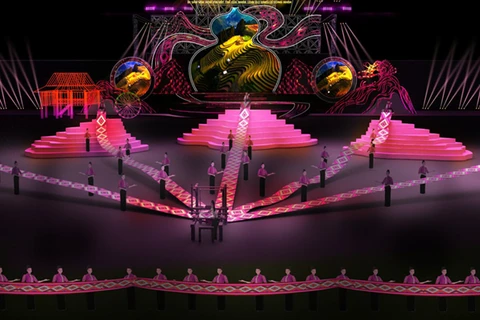 Meritorious Artist Nguyen Tat Kim Hung from Nguyen Khiet Linh Tu temple performs a ritual (Photo: VietnamPlus)
Meritorious Artist Nguyen Tat Kim Hung from Nguyen Khiet Linh Tu temple performs a ritual (Photo: VietnamPlus) Hanoi (VNA) – A training workshop was held in Hanoi on August 26 to seek solutions to problems in the management, protection, and promotion of recognized intangible cultural heritage in Vietnam.
One of the issues attracting attention at the event was whether it is appropriate to “perform” tangible heritage outside its traditional practice space, which was triggered by a recent re-enactment of a hau dong, the central ritual of mother goddess worship, at a university in the central province of Thua Thien-Hue.
Speaking at the event, Meritorious Artist Nguyen Tat Kim Hung from Nguyen Khiet Linh Tu temple at 102 Hang Bac Street, Hanoi, said the worship of the Mother Goddesses of Three Realms is a spiritual heritage rather than an artistic one, so that it must be performed in the space of a place of worship. The tools and objects used in rituals, such as costumes, flags, utensils, incense, offerings, and songs are all considered sacred, and they must undergo a purification process before being used in the rituals to imbue them with a sense of sacredness. They should not be taken outside the temple or shrine space to be used in a performance.
Standing member of the National Assembly’s Committee for Culture and Education Bui Hoai Son said there are many different viewpoints on heritage preservation, leading to various debates. Some argue that heritage must be preserved in its original context and historical significance, while others believe that heritage should be protected through adaptation, meaning it should play a role in a specific social context to better serve socioeconomic development.
According to him, UNESCO has reflected both viewpoints in the 12 ethical principles of safeguarding cultural heritage. This means that communities and individuals should protect their heritage in the most appropriate way, based on a clear understanding of the heritage value. Other communities, scientists or State management agencies should join hands to honour that heritage.
Deputy Minister of Culture, Sports and Tourism Hoang Dao Cuong said the ministry has taken note of the debate surrounding the issue of "performing heritage" in Thua Thien Hue.
The ministry has listened to mixed opinions, he said, adding that the event provides an opportunity for the ministry to consider the issue more carefully and, as a result, provide more detailed and specific amendments to the draft Heritage Law that is currently under revision.
 Deputy Minister of Culture, Sports and Tourism Hoang Dao Cuong speaks at the event (Photo: VietnamPlus)
Deputy Minister of Culture, Sports and Tourism Hoang Dao Cuong speaks at the event (Photo: VietnamPlus) Cuong affirmed that managing intangible heritage is not a simple matter, especially in the midst of changing times. The completion of the revised law will require consensus among management authorities, scientists, and the community who are the practitioners of the heritage.
The consensus in perception will contribute to the building of the law on the protection and preservation of intangible cultural heritage, thus meeting the public needs and aspirations. There must be unity and cooperation within the community and among scientists in order to effectively protect, preserve, and promote the value of heritage, he said.
UNESCO has so far recognized 15 intangible cultural heritages of Vietnam. As many as 1,881 people have been honoured with the titles of "People's Artist" and "Meritorious Artist”. Around 70,000 intangible cultural heritage items have been documented in Vietnam, with 497 listed in the national intangible cultural heritages distributed throughout the country./.
























